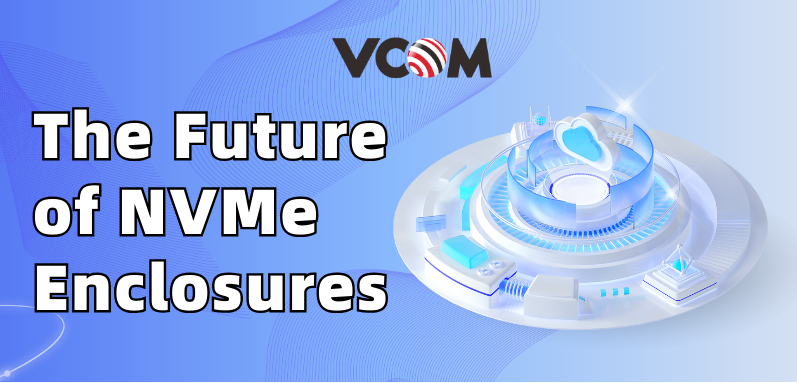
Share
The Future of NVMe Enclosures: USB4, PCIe 5.0 & What’s Next
1. Introduction: Why the Future of NVMe Enclosures Matters
High-speed external storage has become a cornerstone for professionals and enthusiasts in video editing, gaming, data analysis, and enterprise workflows. NVMe enclosures have evolved rapidly, and as new interface technologies like USB4, Thunderbolt 5, and PCIe 5.0 enter the market, understanding these advancements is key for making informed buying and upgrade decisions in 2025 and beyond.
If you’re just starting out or want to refresh your knowledge, check out our NVMe Enclosure Buying Guide: Everything You Need to Know in 2025 for a detailed overview of current products and features.
2. Current State of NVMe Enclosures
Today, the majority of portable NVMe SSD enclosures rely on USB4 or Thunderbolt 4, both of which offer up to 40 Gbps bandwidth—enough to saturate PCIe Gen3 and nearly maximize PCIe Gen4 SSD speeds.
|
Interface Type |
Max Bandwidth |
Typical Applications |
|
USB 3.2 Gen 2x2 |
20 Gbps |
Mid-range storage, backup drives |
|
USB4 / Thunderbolt 4 |
40 Gbps |
Professional video editing, gaming |
|
Internal PCIe 4.0 x4 |
~32 GB/s (256 Gbps) |
Internal NVMe SSD performance |
These interfaces have made external NVMe drives powerful tools for creators who need high-performance storage solutions on the go.
For users migrating from SATA to NVMe, you might find our NVMe vs SATA Enclosure: What's the Difference and Which Do You Need? article helpful to understand performance differences and upgrade considerations.
3. USB4 NVMe Enclosures: The Next Step in External Storage
USB4 has bridged the gap between standard USB protocols and Thunderbolt’s high-bandwidth capabilities. It supports up to 40 Gbps, dynamic protocol tunneling, and backward compatibility, ensuring that users can connect older devices without sacrificing speed.
Key benefits of USB4 NVMe enclosures:
Seamless compatibility with most modern laptops and desktops
Stable, high-speed performance for data-intensive workflows
Lower cost compared to Thunderbolt-only enclosures
For consumers seeking both performance and compatibility, USB4 enclosures remain the mainstream choice in 2025.
If you’re installing an enclosure for the first time, see our How to Install and Use an NVMe Enclosure (Step-by-Step Guide) for a beginner-friendly tutorial.
4. PCIe 5.0 NVMe: Internal Speed Meets External Potential
PCIe 5.0 SSDs, offering speeds up to 14 GB/s, are already reshaping internal storage markets. While external PCIe 5.0 enclosures are still limited due to controller and power constraints, early prototypes show promising results with Thunderbolt 5 and future USB standards.
Current challenges include:
High thermal output requiring advanced cooling designs
Limited availability of compatible controllers
Interface bottlenecks when connected via USB4 (capped at 40 Gbps)
As interface technology advances, expect PCIe 5.0 NVMe enclosures to become standard for power users within the next two years.
As these constraints ease, PCIe 5.0 NVMe enclosures will become a standard choice for creators and professionals. For maintaining top performance, explore our guide on NVMe Enclosure Lifespan and Maintenance: How to Maximize Your SSD’s Health.
5. Thunderbolt 5 and the Next-Gen Leap
Thunderbolt 5, announced in 2023, offers 80 Gbps bi-directional bandwidth with support for 120 Gbps in asymmetric modes, enabling even faster transfers and multi-device daisy-chaining. This interface is ideal for workflows such as 8K video editing, machine learning, and high-capacity backup solutions.
|
Feature |
Thunderbolt 4 |
Thunderbolt 5 |
|
Bandwidth |
40 Gbps |
80–120 Gbps |
|
PCIe Tunneling |
PCIe Gen3 x4 |
PCIe Gen4 x4 |
|
Power Delivery |
Up to 100W |
Up to 240W |
Thunderbolt 5 NVMe enclosures will become the gold standard for professionals seeking uncompromising performance and reliability.
6. Market Trends and Forecasts
The NVMe enclosure market is projected to grow steadily as storage demands increase across sectors like creative industries, enterprise IT, and gaming. Key trends shaping the market include:
Shift toward USB4 and Thunderbolt 5 for universal high-speed connectivity
Growing demand for portable high-capacity drives exceeding 8TB
Focus on thermal management with integrated heat sinks and active cooling solutions
Increased adoption of encryption and hardware-level security for sensitive data
Analyst forecasts indicate that external PCIe 5.0 NVMe enclosures will see significant adoption by 2026, driven by falling SSD prices and the rise of AI and content-heavy workflows.
7. Preparing for Next-Gen Upgrades
When planning to invest in future-proof NVMe enclosures, consider the following:
Interface support: Ensure your system supports USB4 or Thunderbolt 5 for maximum compatibility.
Cooling design: Look for enclosures with aluminum shells or active cooling for PCIe 4.0 and 5.0 drives.
Power delivery: Confirm that the enclosure supports adequate PD for high-performance SSDs.
Firmware upgradability: Devices with updatable firmware offer better long-term support.
8. Conclusion: The Road Ahead
The NVMe enclosure landscape is rapidly evolving. USB4 remains the most practical choice for mainstream users in 2025, while Thunderbolt 5 and PCIe 5.0 are setting the stage for next-gen performance. By 2026, external drives will not only be faster but also smarter, offering better thermal efficiency, higher capacities, and advanced security features.
For professionals and tech enthusiasts, staying updated on these trends ensures that storage solutions remain optimized for speed, reliability, and compatibility in the years ahead.

